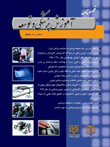The relationship between Employees Level of education and the learning organization profile of Qazvin University of Medical Sciences
Author(s):
Abstract:
Background
Nowadays, organizations to survive and gain competitive advantage require structural changes for conforming to their surrounding environmental changes. Many organizations are becoming learning organizations for this purpose. Objective
The purpose of this article was to determine profile of learner's organization in Qazvin University of Medical Sciences, using continuous system linked organizational model based on different levels of education.Methods
This is an applied study using a practical survey; Statistical community include people in all different organizational levels of Qazvin University of Medical Sciences, (consisting of 1517 people) which have been working during 2008-2009 academic year. Using formula, a sample of 260 people was randomly studied. Sample size allocation to different study groups was according to performance size. Data collection consisted of a questionnaire with 50 questions on a Likert scale. Data analysis was performed by SPSS software using statistical tests ANOVA and Student-T Test. Findings
The results of the research showed a community of 52% women and 48% men; of which 56.15% had a bachelorette degree (BS or BA), 18.85% masters and general practitioners degree (MS, MA or MSc.) and 16.16% specialist's doctorate and PhD degrees. The results showed none of the people in different educational backgrounds evaluated the University as a learning organization. Among the five dimensions of learning organization model; people and knowledge, there was no significant difference at different levels of education. While there was a significant difference (p<0.05) in the learning, organization and technology dimensions. The most points in learning dimension (20.70), organization (19.17) and technology (20.70) and overall assessment (93.91) belonged to groups with less than BA education.Conclusion
According to research results, university in different educational levels was not assess as a learning organization and the weakest subsystems, was related to learning subsystem. No organization can survive without continuous learning. Managers must facilitate learning as a major activity, on this basis, the special attention of university decision makers are needed to move towards a learning organization. In this context the university can establish and develop an on time and flexible learning programs at top of its agenda.Language:
Persian
Published:
Journal of Medical Education And Development, Volume:6 Issue: 1, 2013
Page:
12
magiran.com/p1255663
دانلود و مطالعه متن این مقاله با یکی از روشهای زیر امکان پذیر است:
اشتراک شخصی
با عضویت و پرداخت آنلاین حق اشتراک یکساله به مبلغ 1,390,000ريال میتوانید 70 عنوان مطلب دانلود کنید!
اشتراک سازمانی
به کتابخانه دانشگاه یا محل کار خود پیشنهاد کنید تا اشتراک سازمانی این پایگاه را برای دسترسی نامحدود همه کاربران به متن مطالب تهیه نمایند!
توجه!
- حق عضویت دریافتی صرف حمایت از نشریات عضو و نگهداری، تکمیل و توسعه مگیران میشود.
- پرداخت حق اشتراک و دانلود مقالات اجازه بازنشر آن در سایر رسانههای چاپی و دیجیتال را به کاربر نمیدهد.
In order to view content subscription is required
Personal subscription
Subscribe magiran.com for 70 € euros via PayPal and download 70 articles during a year.
Organization subscription
Please contact us to subscribe your university or library for unlimited access!


